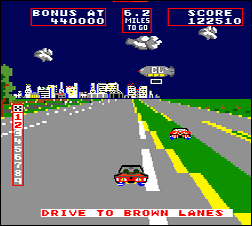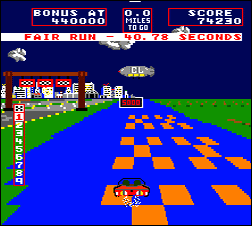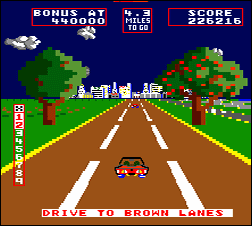 The Game: The future! A dystopia of fast driving! Players are behind the wheel of a multi-terrain vehicle that can switch from fast handling on solid surfaces to amphibious speedboat in the blink of an eye. The currency of this violent future is fuel for this vehicle, and enemies in similar vehicles and in airborne vehicles will stop at nothing to claim fuel for themselves, regardless of the player’s safety. Grey highways and rivers are the usual modes of travel, though brown highways offer faster travel. Checkpoints must be reached in the correct order to rack up bonus points (players who arrive at the wrong checkpoint will be greeted with a checkerboard pattern instead of a number), but all checkpoints, even the wrong ones, grant players extra fuel. Surface enemies can be rammed out of the way, but there’s no honor lost in surviving by throwing the vehicle into reverse gear. Whoever survives the longest and scores the highest is crowned the Supreme King of the World. (Taito America, 1982)
The Game: The future! A dystopia of fast driving! Players are behind the wheel of a multi-terrain vehicle that can switch from fast handling on solid surfaces to amphibious speedboat in the blink of an eye. The currency of this violent future is fuel for this vehicle, and enemies in similar vehicles and in airborne vehicles will stop at nothing to claim fuel for themselves, regardless of the player’s safety. Grey highways and rivers are the usual modes of travel, though brown highways offer faster travel. Checkpoints must be reached in the correct order to rack up bonus points (players who arrive at the wrong checkpoint will be greeted with a checkerboard pattern instead of a number), but all checkpoints, even the wrong ones, grant players extra fuel. Surface enemies can be rammed out of the way, but there’s no honor lost in surviving by throwing the vehicle into reverse gear. Whoever survives the longest and scores the highest is crowned the Supreme King of the World. (Taito America, 1982)
Memories: Before there was RoadBlasters, before the first-person-driving-and-combat genre became a fleeting fixture on the arcade landscape, there was Taito‘s Change Lanes, an aggressive novelty in an increasingly crowded field of first-person racers. Sure, games like Pole Position and Turbo offered us the chance to race with an unprecedented view…but Change Lanes changed the venue, setting it in a kind of genteel Mad Max-inspired world: sure, fuel is a precious commodity, and in-game enemies will kill to keep the player from acquiring it…and yet someone’s maintaining the infrastructure. Good job on those frictionless brown lanes, infrastructure people.
 The game’s graphics are smooth and fast, perhaps not as detailed as Change Lanes’ aforementioned first-person-racer brethren, but it’s impressive that they’re as detailed as they are when they whiz past the player’s perspective as fast as they do. It’s impressive scenery for the speed with which the game’s Z80-based hardware has to generate it. The bizarre combination of pleasant scenery and violent competition really fired this author’s young imagination: who maintains the highways for the Supreme King of the World?
The game’s graphics are smooth and fast, perhaps not as detailed as Change Lanes’ aforementioned first-person-racer brethren, but it’s impressive that they’re as detailed as they are when they whiz past the player’s perspective as fast as they do. It’s impressive scenery for the speed with which the game’s Z80-based hardware has to generate it. The bizarre combination of pleasant scenery and violent competition really fired this author’s young imagination: who maintains the highways for the Supreme King of the World?
 As a somewhat humorous minor note, credit in the copyright filing for Change Lanes reveals that Taito shares credit with an entity called Software & Hardware Innovative Technologies. (The reader is left to figure out the acronym on their own time.) The game was designed by Dave Needle (1947-2016), future co-inventor of the Atari Lynx, the 3DO console and the Amiga home computer, and it was turned down by Bally/Midway before finding a home at Taito. Though the game itself states a copyright date of 1983, Change Lanes was initially rolled out late in 1982.
As a somewhat humorous minor note, credit in the copyright filing for Change Lanes reveals that Taito shares credit with an entity called Software & Hardware Innovative Technologies. (The reader is left to figure out the acronym on their own time.) The game was designed by Dave Needle (1947-2016), future co-inventor of the Atari Lynx, the 3DO console and the Amiga home computer, and it was turned down by Bally/Midway before finding a home at Taito. Though the game itself states a copyright date of 1983, Change Lanes was initially rolled out late in 1982.
 Somewhere between its ultra-smooth controls, its bizarre in-game world, and its satisfying opportunities to drive through opponents instead of around them, Change Lanes was a harbinger of an interesting genre mash-up in the making, and remains strangely addictive.
Somewhere between its ultra-smooth controls, its bizarre in-game world, and its satisfying opportunities to drive through opponents instead of around them, Change Lanes was a harbinger of an interesting genre mash-up in the making, and remains strangely addictive.
